Exploring the Depths of Natural Garnet: Formation and Significance


Intro
Natural garnet, with its deep hues and captivating brilliance, has been a subject of fascination for gem enthusiasts and jewelry designers alike. Known for its versatility, this gemstone offers an array of shades and types, each presenting unique characteristics and stories. By exploring its geological formation, varieties, and historical significance, one can gain a deep appreciation for garnet not merely as a decorative stone but as a gem steeped in culture and history.
In this comprehensive guide, we’ll delve into the fascinating world of natural garnet, from understanding its definition as a gemstone to unpacking its ancient usage in various civilizations. At every turn, we will illuminate the aesthetic appeal garnet holds, delving into its metaphysical properties while providing insights into the meticulous care needed to preserve its beauty.
Alongside these insights, we will navigate the practicalities of identifying genuine garnet stones and how to make informed purchases in the market. By the end of this narrative, readers will not only possess substantial knowledge about garnet but also foster a greater appreciation for this remarkable gemstone.
Preamble to Natural Garnet
Natural garnet holds a unique place in the realm of gemstones. Its remarkable blend of beauty, durability, and historical significance makes it a fascinating subject. This section strives to unpack the allure of garnet, offering readers insight into its varied character and importance.
Defining Natural Garnet
At its core, natural garnet is not just one type of gemstone but a group of silicate minerals that occur in myriad varieties. Each variety of garnet possesses distinct chemical compositions and physical properties, which lend themselves to a diverse range of colors. When you hold a garnet, you’re often holding more than just a stone. It embodies a kaleidoscope of geological processes.
The most prevalent types include almandine, pyrope, grossular, spessartine, and andradite, each boasting its own color palette, from the rich reds to vibrant greens and even the rare blues. It’s worth noting that garnet is commonly recognized for its use in jewelry, yet its applications extend far beyond adornment; garnet’s hardness and abrasive qualities have found use in industrial settings as well.
Historical Background
When tracing the footsteps of garnet through history, one uncovers a tapestry rich with cultural significance. The history of garnet dates back to ancient civilizations. Archaeological evidence shows that garnets were prized by the Egyptians, who crafted stunning jewelry and utilized them in burial artifacts, believing they provided protection in the afterlife.
The Middle Ages witnessed garnets in Europe taking form within impressive ecclesiastical pieces, symbolizing power and prestige. Additionally, the trade of garnets along the Silk Road played a pivotal role in exchanging not just gemstones but also cultural narratives between distant lands.
"Garnet has adorned the tombs of pharaohs and the necklines of kings; its journey through history is nothing short of remarkable."
In summary, understanding the foundational aspects of garnet—its definition and historical background—provides crucial context for appreciating its geological formation, varieties, and the myriad ways it has shaped human culture. This exploration sparks curiosity about the multifaceted nature of this exquisite gemstone, setting the stage for a deeper dive into its geological formation and other intriguing aspects.
Geological Formation of Garnet
Understanding the geological formation of garnet is essential for grasping its characteristics and significance in the realm of gemstones. Garnets are not merely pretty stones; their formation processes reveal a lot about the earth's history and geological activity. These processes offer insights into how pressure and temperature influence the crystal structure and composition of garnets. This section will delve into the intricate details behind the formation of garnets, exploring geological processes and locational variations that contribute to their diversity.
The Geological Processes Involved
Garnets form through metamorphism, which is the alteration of rocks due to changes in temperature, pressure, or chemical conditions. Specifically, garnets arise in high-pressure and high-temperature environments, often deep within the Earth's crust. This metamorphic process can be seen in various rock types, like schist and gneiss.
During metamorphism, elements like aluminum, iron, magnesium, and silica combine to create the distinct garnet crystal structure. The pressure – sometimes reaching several kilobars – and elevated temperatures above 500 degrees Celsius work as catalysts for this transformation. The unique chemistry of the parent rock plays a crucial role in determining the type of garnet that forms, whether it be Almandine, Pyrope, or another variety.
It's fascinating to note that garnets can also be formed in igneous settings, particularly when molten rock cools and solidifies over time. This often happens in volcanic regions where the cooling magma allows for the crystallization of garnets amidst other minerals. Understanding these geological processes uncovers the complex nature of garnet formation and highlights its connection to Earth's geological history.
Locational Variations
The formation of garnet is not just a one-size-fits-all scenario. Different regions on Earth offer unique geological settings that produce garnets with diverse attributes and characteristics.
Major Garnet Deposits
Major garnet deposits are scattered across the globe, each offering distinctive features that contribute to garnet's popularity in various applications. The notable deposits in Rajasthan, India, for instance, are rich in Almandine garnets. The distinctive deep red color from this region makes it a sought-after choice for both jewelry and industrial uses. The granites in India often contribute to garnet’s accessibility on the market, allowing a greater number of collectors and enthusiasts to appreciate it.
In contrast, the garnets found in Myanmar, especially the Pyrope variety, tend to be larger and more transparent. Their unique characteristics make them highly desirable among jewelry designers looking for high-quality stones. The advantages of these deposits lie in their vast supply; however, factors such as political stability and mining practices can influence both availability and ethical sourcing.
This regional diversity not only enriches the garnet market but also provides insights into local geological conditions and mining practices, allowing for a deeper understanding of these treasured gemstones.
Garnet Throughout the Ages
The historical journey of garnets showcases their importance beyond mere aesthetics. Over the years, different cultures have cherished garnets for their metaphysical properties and historical significance. During the Middle Ages, garnets were believed to have protective qualities, serving as talismans for travelers and warriors. Historical accounts indicate that they were often used in royal jewelry, enhancing the wealth and status of monarchs.
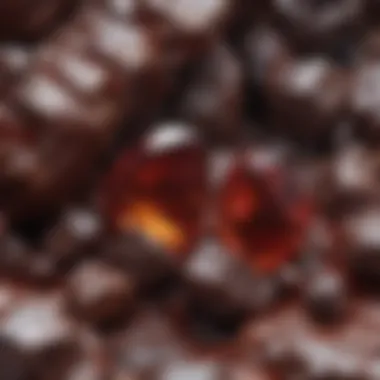
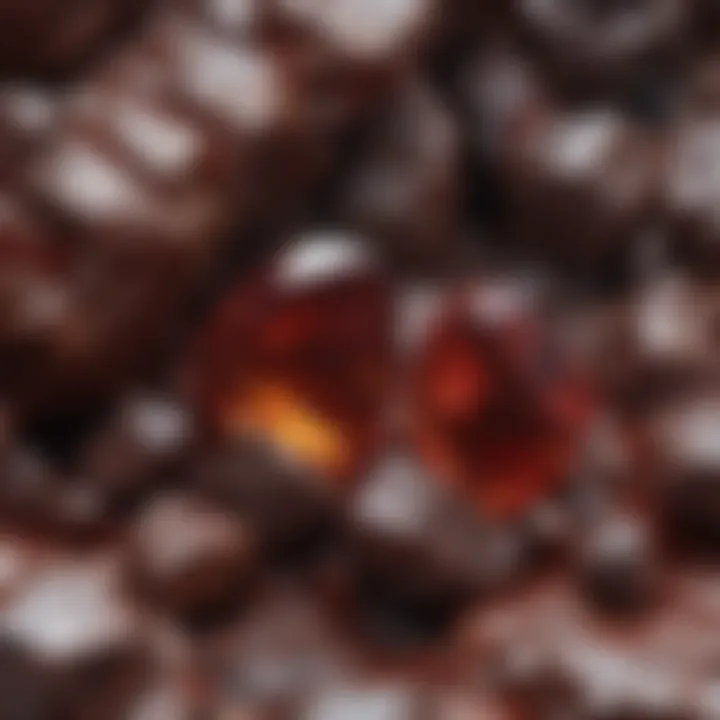
From the glowing red garnets adorning the crowns of royalty to the earthy varieties used in tribal adornments, garnets reflect humanity's deep connection to gemstones. Their durability and vibrant hues ensure they remain popular choices in contemporary jewelry design. What stands out is how garnets have maintained a timeless allure through the passage of time, spanning across cultures and epochs. Their continual re-emergence in fashion and symbolism solidifies their place in gemstone history.
Varieties of Natural Garnet
The world of natural garnet is a tapestry woven with many colors, varieties, and stories. Understanding the different types of garnets is important not just for aesthetics but also for appreciating their unique properties and historical significance. Each variety can tell a story, reflect cultural influences, and offer distinct uses. By diving into the variations, enthusiasts and collectors gain a more profound appreciation of this remarkable gemstone.
Classification of Garnet Types
Almandine Garnet
Almandine garnet stands out as one of the most recognized types, often appearing in deep red shades. This form of garnet is usually found in metamorphic rocks and is characterized by its hardness and durability. A key feature of almandine is its rich color, often drawing comparisons to rubies, although garnet tends to be more affordable. This gemstone's quality and price make it a beneficial choice for jewelry, particularly in engagement rings or statement pieces.
One unique feature of almandine garnet is its ability to exhibit two types of pleochroism—changes in color when viewed from different angles. This trait adds a layer of fascination for those who appreciate gemology. however, the darker tones can sometimes mask lighter inclusions. Thus, one must examine closely to ensure quality.
Pyrope Garnet
Pyrope garnet dazzles with its vivid red hues, often likened to the color of a pomegranate seed. Its prominence lies in its emotional connection, often symbolizing love and passion. Jewelers highly regard pyrope's brilliance, which makes it a popular choice in various adornments.
The striking aspect of pyrope garnet is its resistance to fading, even under sunlight, marking it as a long-lasting choice for everyday wear. While its radiance is appealing, it tends to be rarer than almandine, which can drive up its cost. The rarity, mixed with its enchanting color, firmly places pyrope garnet as a staple in the world of gemstones.
Spessartine Garnet
Unlike its red cousins, spessartine garnet boasts vibrant orange to reddish-orange hues. Its unique coloration comes from manganese content, differentiating it from other garnets. Spessartine garnet is particularly cherished for its life-affirming shades that can uplift any jewelry piece.
A unique aspect of spessartine is its rarity; it's often harder to find compared to more common garnet varieties. Some collectors relish the challenge of seeking spessartine gems. However, because they can be more expensive, buyers must weigh their options against other garnet types.
Grossular Garnet
Grossular garnet varies greatly in color, featuring shades that range from green to colorless, and even pink. This versatility makes it a favorite among designers who look to create unique and expressive jewelry. A key aspect of grossular is its relative abundance compared to other varieties, making it more accessible to the average buyer.
One distinct characteristic of grossular garnet is its ‘Tsavorite’ form, which is a vibrant green color highly sought after in the market. These green gems symbolize prosperity and are often used in spiritual practices. While it generally offers a more affordable price point, some of the rarer hues like pink can still fetch a significant price in the market.
Andradite Garnet
Andradite garnet comes in several shades, often described as ranging from yellow to green and even dark brown. Its most lustrous form, known as ‘Demantoid,’ is famed for its incredible brilliance and fire, comparable to diamonds. This property makes andradite gems exceptionally desirable.
Among its many attributes, the unique texture of andradite garnet can display exceptionally beautiful inclusions, which can capture attention and interest. While its captivating look often leads to higher prices, the investment can be worthwhile for collectors keen on owning rare specimens.
Color Variations and Their Significance
Colors in garnet can vary widely—from deep reds to bright greens and soft pinks. Understanding the significance behind these variations offers insights into not just their market value but also cultural meanings and personal preferences. For instance, red garnets are often seen as symbols of love, while green garnets can imply growth and healing.
With the diverse range of garnet types and colors, gemstone enthusiasts, collectors, and jewelry designers can find pieces that resonate with their personal stories and aesthetic tastes.
Aesthetic and Metaphysical Properties
Natural garnet is not merely a stone; it embodies a blend of beauty and layered meanings that have captivated humans through the ages. The exploration of its aesthetic and metaphysical properties lends itself to a deeper appreciation of garnet not just as a jewel, but as a cultural icon and a beacon of emotional strength.
Visual Characteristics
The allure of garnet lies in its rich, diverse colors and striking brilliance, making it a favorite among gemstone collectors and jewelry enthusiasts alike. Ranging from the deep red of Almandine to the vibrant green of Tsavorite, each variety presents a unique visual appeal. This variability can be attributed to the mineral composition of garnet, leading to a kaleidoscope of shades and patterns.
One notable visual characteristic is garnet’s ability to exhibit different hues under varying lighting conditions, known as "color change." For example, some specimens may appear a reddish-brown in daylight but shift to a purplish hue under incandescent light. This fascinating attribute not only enhances garnet's aesthetic value but also makes each piece distinctly unique, much like the individuals who wear them.
Beyond color, garnet also boasts a high refractive index, contributing to its brilliance and sparkle. This quality is essential for those designing jewelry, as it reflects light in a way that often outshines other gemstones, enhancing the visual drama of a piece. Additionally, garnet can display inclusions and characteristic patterns that can even tell a story of its geological origins—a true testament to its natural beauty.
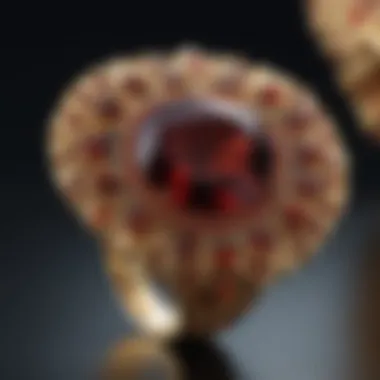
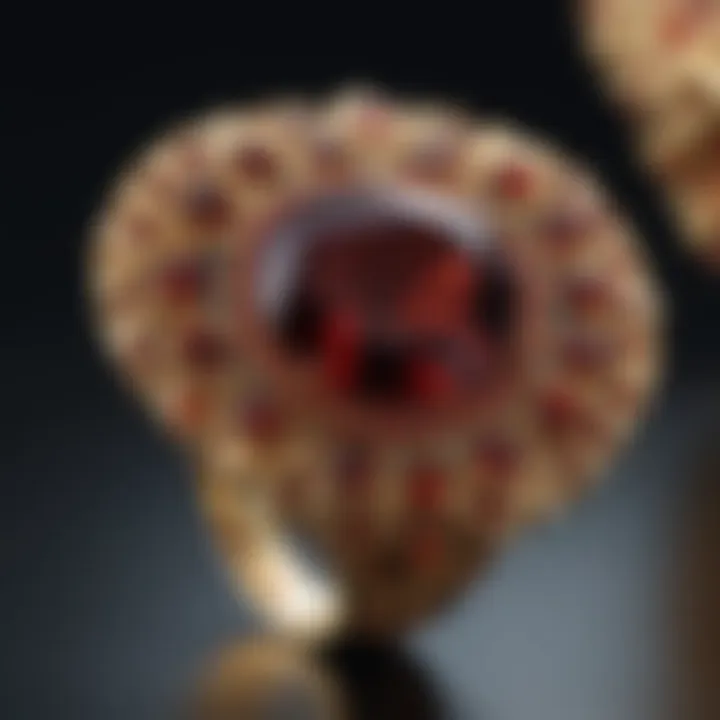
Metaphysical Beliefs and Uses
Garnet’s significance transcends the physical realm, deeply rooted in various metaphysical beliefs. Historically, it has been associated with a sense of protection and grounding. Many cultures viewed garnet as a symbol of safety, thought to guard against misfortune and ensure safe travels. It has often been gifted to loved ones embarking on journeys, reflecting the belief that garnet provides a shield against harm.
In the realm of emotional healing, garnet is said to stimulate the root chakra, harnessing energy that promotes stability, balance, and vitality. This stone is often believed to encourage resilience in challenging times and ignite passion—both in life and love.
Furthermore, garnet is sometimes regarded as a stone that fosters self-confidence and courage. Users report that carrying or wearing garnet imbues them with an elevated sense of focus and determination, essential traits for achieving personal goals or overcoming obstacles. This makes it a desirable choice not just for aesthetic appreciation but also for those seeking emotional clarity.
"The garnet is more than a mere ornament; it is an emblem of your journey through life, filled with resilience and promise."
Cultural Significance of Garnet
The cultural significance of garnet extends far beyond its aesthetic charm. This gemstone has been cherished throughout history, deeply woven into various traditions and belief systems. Its multifaceted nature, symbolizing love, commitment, and protection, has afforded garnet a foothold in diverse cultures globally.
Historical Use in Jewelry
Throughout ages, garnet has often graced the adornments of royalty and the affluent. The gemstone gained prominence from ancient Egypt, where pharaohs and nobility wore garnets not only for their beauty but also because they were believed to contain protective properties. Ancient artifacts, such as intricately crafted jewelry pieces dating as far back as 3100 BC, reflect garnet's long-standing popularity. Those wearing garnet believed that the stone could help fend off evil spirits and provide safety during travels.
Garnet's allure does not stop in Ancient Egypt. During the Middle Ages, it was a favored choice among the aristocracy in Europe. Craftsmen would often embed garnets into various jewelry forms, including brooches and rings. Its deep reds and vibrant colors were ideal for statement pieces and soon became a hallmark for those wishing to signal their wealth and status. In many cultures, garnets symbolized fidelity and devotion, making them a popular choice for engagement rings and wedding gifts.
Moreover, artisans employed garnets not just for their color but also for their durability. Unlike other stones which may chip or crack easily, garnets stood the test of time, making them appropriate for heirloom pieces passed down through generations.
"In wearing garnet jewelry, individuals have connected emotionally through their complex meanings— a blend of personal, historical, and cultural narratives woven together in the fabric of time."
Garnet in Mythology and Symbolism
The lore surrounding garnet intertwines with mythology, illustrating its significance across various cultures. In Greek mythology, garnet is linked to Persephone, the goddess of spring growth. Legends suggest that after her abduction by Hades, she was given garnet seeds, symbolizing her enduring connection to life and rebirth. This belief fosters the stone’s association with regeneration and passion, cherished by those seeking emotional rejuvenation.
Regional lore also holds that garnets served as a talisman for warriors heading into battle. They were thought to instill bravery and strength, nurturing courage amidst chaos. Many believed that garnets' red hue mirrored the blood of warriors, embodying valor and tenacity.
In Eastern cultures, garnets often symbolize wealth and prosperity. It’s been said that carrying this gemstone can attract abundance, often making it a gift among influential sectors of society. The rich history of garnet contributes to its diverse meanings— a mosaic of beliefs that echo themes of love, strength, and fortuity.
Through these narratives, garnet not only serves a decorative purpose but also fosters emotional connections, allowing individuals to reflect on their values, aspirations, and relationships. Understanding these cultural undercurrents enriches one’s appreciation for garnet, making it an object of desire steeped in history and significance.
Care and Maintenance of Garnet Jewelry
When it comes to owning natural garnet jewelry, understanding how to properly care for these pieces extends their longevity and preserves their beauty. Garnets may be admired for their rich colors and effectiveness in various gemstone applications, but they are also durable with a hardness of about 7 to 7.5 on the Mohs scale. Despite this, proper maintenance is key. Failing to care for garnet jewelry can result in dullness, scratches, and even irreparable damage over time.
Maintaining garnet jewelry requires a balance of regular cleaning and strategic storage. Collectors and enthusiasts should approach garnet care with knowledge of its unique properties, ensuring that each piece remains a worthy investment.
Cleaning Techniques
Keeping garnet jewelry clean is essential for showcasing its natural brilliance. The cleaning process isn’t complicated, but there are specific considerations to keep in mind:
- Soap and Water: A simple solution of mild soap and lukewarm water can work wonders. Soak the jewelry for a short period, then gently scrub with a soft brush to remove any dirt. Rinse thoroughly and pat dry with a lint-free cloth.
- Avoid Harsh Chemicals: Products like bleach or ammonia can damage not just garnets but many other stones too. Always err on the side of caution and stick to gentler cleaning agents.
- Ultrasonic Cleaners: While most garnets can handle ultrasonic cleaning, it’s always best to double-check if your specific garnet type is safe. Some garnets can fracture if exposed to too much vibration.
Remember: Regular, gentle cleaning prevents dirt build-up, which can dull the stone's surface over time.
Storage Recommendations
Proper storage of garnet jewelry plays a crucial role in maintaining its quality. Here are some practices to keep in mind:
- Separate Storage: Store each garnet piece separately in its own soft pouch or a box lined with a soft material. This prevents scratching from contact with other jewelry.
- Cool, Dry Environment: Excess humidity can affect the stone's integrity. Keeping garnets in a controlled environment helps prevent deterioration.
- Avoid Direct Sunlight: Prolonged exposure to sunlight can alter garnet color. A dark, cool drawer or jewelry box is ideal for preserving their rich hues.
Identifying Authentic Garnet
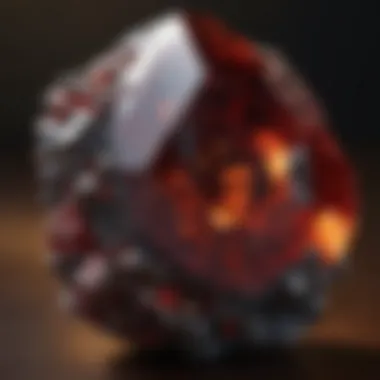
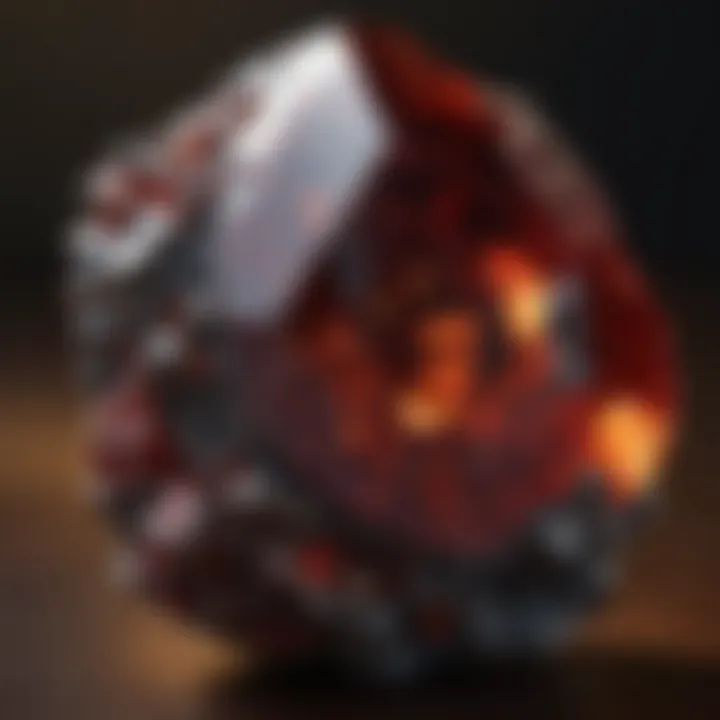
Identifying authentic garnet is crucial, especially for anyone looking to invest in this captivating gemstone. With its popularity in the jewelry market, the risk of encountering imitations or other stones that may merely resemble garnet increases. By honing the ability to discern genuine garnet, collectors, jewelers, and enthusiasts can ensure they are not duped into purchasing less valuable alternatives. This section explores the pivotal characteristics and common misidentification pitfalls associated with this gemstone, equipping you with practical knowledge for navigating your garnet journey.
Key Characteristics of Genuine Garnet
To properly identify genuine garnet, one needs to be aware of several key characteristics that can distinguish it from lookalikes. These characteristics include:
- Color: Garnets are famed for their vivid colors that range from deep reds to fiery oranges and greens. While some imitations may try to mimic these shades, the depth and luminescence of authentic garnet cannot be replicated easily.
- Hardness: Garnet has a hardness of 6.5 to 7.5 on the Mohs scale, which makes it reasonably durable. If another stone scratches easily, it’s likely not garnet.
- Refractive Index: Genuine garnet typically has a refractive index ranging from 1.72 to 1.94. A simple gem tester can help you measure this property when checking for authenticity.
- Inclusions: Under magnification, true garnets might show small inclusions or imperfections. If a stone appears completely flawless, this could be a red flag indicating it’s synthetic or a different mineral altogether.
- Weight: Garnets, especially larger pieces, tend to be heavier than glass or plastic imitations. Hold the stone in your hand and assess its heft—light stones might be fake.
"The beauty of a stone lies not only in its aesthetics but also in its authenticity. No invested collector wants to swim in a sea of fakes."
Common Misidentifications
While garnet is a stunning gemstone, there are a number of stones that can lead to confusion among untrained eyes. Recognizing these common misidentifications can help you make more informed decisions:
- Red Glass: Often mistaken for garnet due to its similar color, red glass lacks the hardness and distinct characteristics of garnet. Testing its scratch resistance will often reveal its true nature.
- Synthetic Garnets: Man-made garnets can appear similar, but they often have perfect clarity and lack natural inclusions. Knowing the provenance of a stone is essential.
- Spinel: This gem can also be red and shares some properties of garnet. However, its hardness is slightly lower, and it exhibits a different reaction when subjected to UV light.
- Tourmaline: In green hues, this stone can also be confused with certain garnets. The microscopic features differ significantly, so using a loupe can help clarify.
- Ruby: While ruby is a more precious stone, its red variations can be mistaken for garnet. However, rubies have a specific gravity that is different from garnet, helping to distinguish them upon weighing.
Knowing these identifiers can aid in successfully acquiring authentic garnet while avoiding potential pitfalls in your gemstone journey.
The Market for Natural Garnet
The market for natural garnet holds significant importance in the gemological world as it encapsulates the intricate relationship between the value of this gemstone and the preferences of gemstone enthusiasts. Collectors, jewelry designers, and geology aficionados alike find themselves drawn to garnet due to its rich history, stunning variety, and metaphysical attributes. Understanding this market not only benefits those looking to invest in garnets but also enriches the overall appreciation of these captivating gems.
With arbor hues ranging from deep red to bright green, garnets can be found in diverse environments and forms. This variety reflects not only geological processes but also influences buyer choices. There’s an art to selecting garnets, influenced by factors like color, clarity, and cut. Buyers must also be wary of imitations; knowledge about where to purchase genuine stones is invaluable. This section delves into vital insights regarding purchasing and pricing natural garnets, illuminating pathways toward quality acquisition.
Where to Buy Genuine Garnet
Shopping for genuine garnet requires a discerning eye and knowledge of reputable sources. Here are some avenues to explore:
- Local Jewelry Stores: Visiting dedicated jewelers who specialize in gemstones is often one of the best bets for acquiring authentic garnet. They can provide insights into the gemstones’ origins and unique characteristics, fostering trust.
- Gem Shows: Events like the Tucson Gem and Mineral Show can offer you the chance to meet multiple vendors and see a wide spectrum of garnets firsthand. These shows can be both enlightening and rewarding, as you might unearth rare specimens.
- Online Retailers: Websites like Etsy or specialized gemstone retailers often have diverse options. Ensure they provide clear return policies and gemstone certifications to verify quality.
- Auction Houses: Auctions can be treasure troves for unique garnets. Renowned auction houses often authenticate their gems, providing assurance of quality.
- Mining Communities and Local Artisans: In some regions famous for garnet mining, purchasing directly from miners or artisans can offer unparalleled insights into the gemstone’s origin.
In any case, always do your homework. Research each source and look for reviews or testimonies about their dealings.
"When buying garnet, authenticity is key; ensure you’re getting what you pay for."
Understanding Garnet Pricing
Garnet pricing can vary drastically, influenced by several essential factors. Recognizing these can guide collectors and buyers in making informed decisions:
- Type of Garnet: Different varieties carry unique values. For example, Tsavorite garnets, known for their vivid green, are typically more expensive than common Almandine garnets.
- Color: The intensity and rarity of the color heavily impact value. Rich, saturated colors fetch higher prices, while pale or overly dark hues may lower value.
- Clarity and Cut: Like many gemstones, clarity plays a vital role. Flawless garnets are rare and command premium prices. Additionally, the quality of the cut can affect not only appearance but also retail price.
- Origin: Some garnets from specific locations, like the famous deposits in Madagascar or the Ural Mountains, hold historical significance and can demand a higher price.
- Market Trends: Keep an ear to the ground about trends in the gemstone industry. Prices can fluctuate based on demand and the availability of new sources or varieties.
This understanding can be the difference between acquiring a wonderful gem at a fair price and overpaying for something that doesn't meet expectations. With an eye for high-quality garnets and an awareness of market fluctuations, buyers can feel confident in their selections.
The End
Natural garnet holds a significant place in the realm of gemstones, not only due to its beauty but also because of its rich geological and cultural history. It is a gem that carries stories from the earth and human interaction dating back centuries. Through this article, we have traversed the many layers of what garnet represents, from its formation, varieties, and metaphysical properties, to its cultural significance and practical care advice. Understanding the multifaceted nature of garnet allows enthusiasts and collectors to appreciate each stone much more deeply.
Summarizing the Importance of Natural Garnet
Natural garnet is hailed not just for its dazzling hues but also for the stories tied to its existence. The significance of this gemstone can be broken down into several key points:
- Diversity: The variety of garnet types, each with its unique color, transparency, and composition, provides something for every taste. Whether it’s the deep red Almandine or the cheerful green Grossular, garnets offer a palette that caters to different preferences.
- Cultural Heritage: Garnets have been treasured across cultures. From the ancient Egyptians adorning their tombs with garnet jewelry to modern jewelers incorporating them into bespoke pieces, their historical weight brings a sense of connection to the past.
- Healing and Metaphysical Properties: Many believe in the metaphysical attributes of garnets, claiming they can promote emotional and physical healing. This added layer strengthens the appeal, particularly for those who appreciate not only the aesthetics but also the spiritual aspects of gemstones.
- Economic Value: Understanding garnet pricing equips buyers and collectors with the knowledge to make informed decisions. The market can be tricky, yet armed with information about genuine stones, folks can avoid common pitfalls.
As we conclude this exploration, it is clear that garnet is more than just a beautiful stone; it embodies history, culture, and possibly even a bit of magic.
Future Perspectives on Garnet in Gemology
Looking ahead, the future of garnet holds promise for gemologists and collectors alike. Here are some insights into possible developments:
- Sustainable Practices: As demand for ethically sourced materials increases, garnet mining and processing might shift towards more sustainable methods, ensuring that future generations can enjoy these beautiful stones.
- Technological Advancements: New technologies in gemology could lead to more accurate identification and grading processes. Labs could develop enhanced techniques for measuring clarity, color variations, and geological origins, providing a clearer understanding of each stone’s worth.
- Expanded Market Access: Online platforms like Reddit and Facebook have opened avenues for discussions and trade among enthusiasts, potentially making garnet more accessible to a broader audience without relying solely on traditional jewelry stores.
- Educational Initiatives: As garnet garners more attention, there could be a rise in educational programs focusing on gemology, teaching amateur enthusiasts and seasoned collectors about the intricacies of these remarkable stones.
With these elements, one can see that natural garnet is not merely a relic of the past; it is a gemstone that continues to evolve in significance and value. As we move forward, maintaining an appreciation for the depth and richness of garnet will ensure its place in both the market and the hearts of gemstone lovers.



